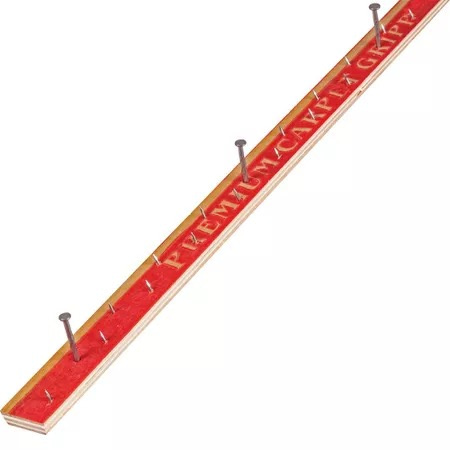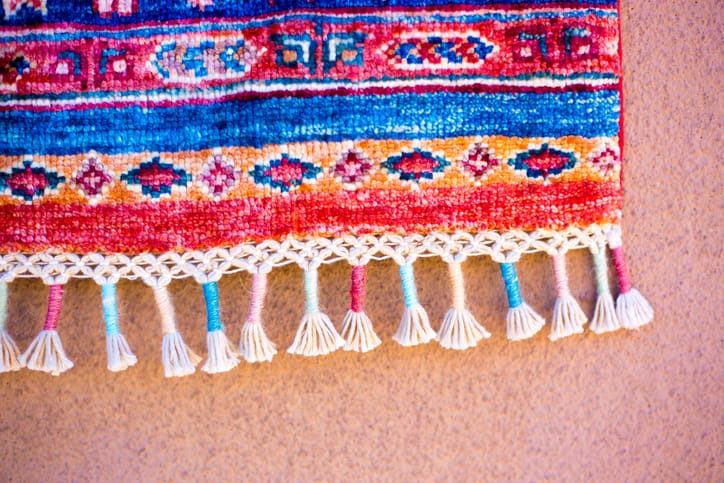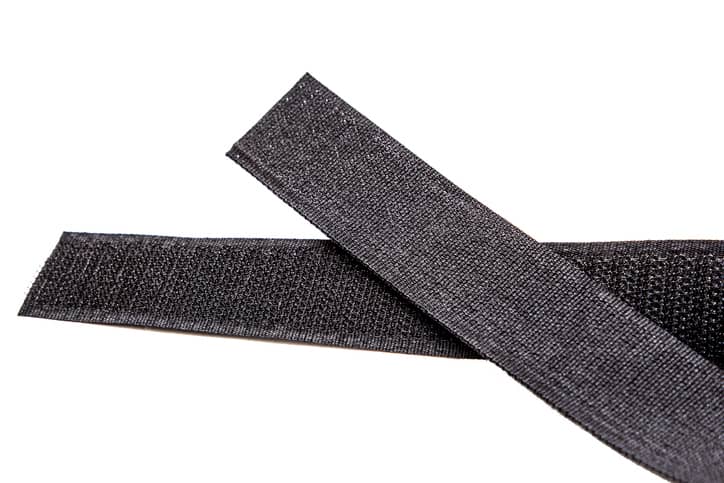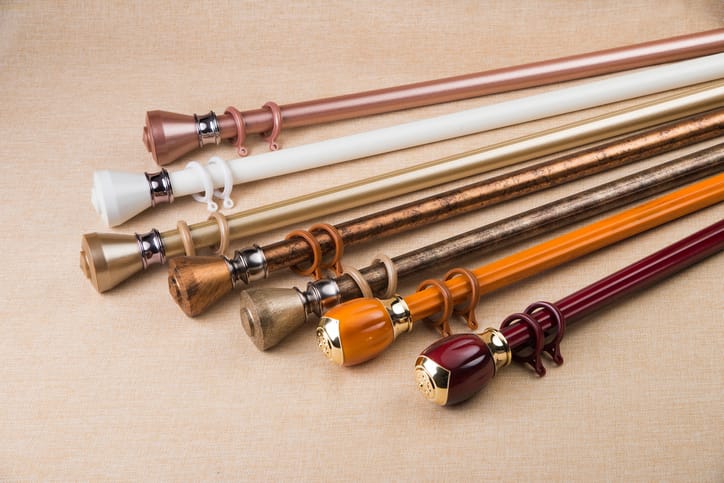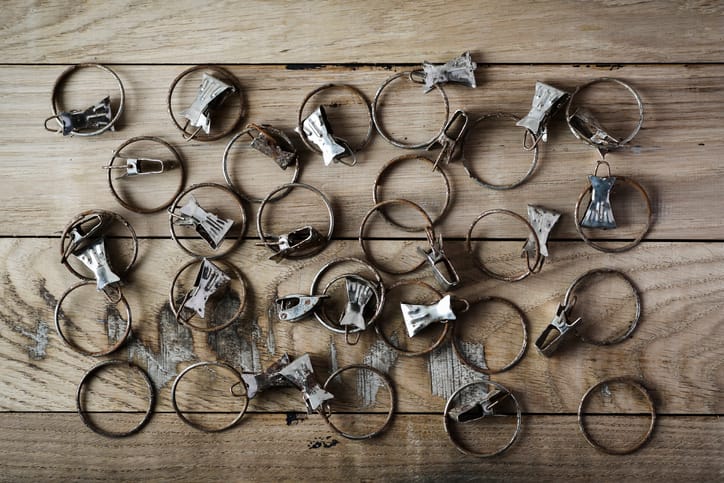https://www.loveyourrug.ca/area-rug-blog/everything-you-need-to-know-about-how-to-hang-a-wall-rug/
Rugs should never be hung directly above or very near a heat source (such as a heat vent or fireplace). They should also never be hung by nailing or pinning them to the wall. The weight of the rug pulling against the nails will cause stress on the fibers and will irreparably damage the rug.
How to Hang a Rug Using PVC Pipe
While this may not be the easiest method to hang a rug, the final product looks incredibly professional. Before you start, gather your materials and find a place you can lay the rug out flat while you work.
Materials You'll Need
- Twine
- PVC pipe
- Saw
- Drill
- Nails
Step 1: Cut the PVC to Size
We recommend buying a PVC pipe ¾ inches in diameter but pick a width that works for the thickness of your rug. Using a tape measure—or simply eyeing it against your rug—cut the PVC pipe about one inch shorter than your rug's width. This way, it will support the rug without being visible on the wall.
Step 2: Measure Several Pieces of Twine
Cut about two or three pieces of twine that are roughly double the length of the PVC pipe. If you have a heavy rug, use more twine, but a lighter rug will be fine with fewer pieces. Then, string all of those pieces through the PVC pipe.
A thick twine like jute is the most sturdy, but you may find yourself cleaning up fibers. If you want a cleaner look, opt for cotton twine.
Step 3: Fold the Rug Over the PVC Pipe
Arrange your rug over the PVC by folding it so that half of the rug is draping down on both sides. This hanging method is ideal for rugs with repeated patterns throughout the piece because one side will always be against the wall.
Step 4: Tie the Twine Together
With the twine strung through the hole of the PVC pipe, take the loose ends and tie them together so that the string creates a closed loop through the PVC pipe. This looped twine will be what your rug hangs from.
Tuck the tied ends through the PVC pipe so they are not visible. Using washers can help weigh the string down and keep it inside the pipe.
Step 5: Hang the Rug Using the Twine
Once the twine is secure, place a nail into the wall and hang it from the twine. If your rug is heavy, you'll want to use an anchor to secure the screw and keep the hanging from damaging the wall.
How to Hang a Rug Using Carpet Tacks
Another incredibly easy way to turn that rug into a piece of wall art is by using carpet tack strips. These are easily found at hardware stores and are small pieces of wood with nails traditionally used to place carpeting on the floor.
Materials You'll Need
- Carpet tacks
- Upholstery nails
Halex Carpet Tack Strip $3.00
Step 1: Cut the Strips to Size
First, take the carpet tack strips and cut them to the width of your rug. Unlike the other method, you'll want the strips to be as long as the rug so you don't get drooping or saggy edges. You will probably need a few strips, depending on the width of your rug.
Step 2: Coat the Strips
Before you hang the wood pieces, take a clear poly finish and paint a sheer coat over all of the strips. This will help protect your rug from acid in the wood so you don't have any discoloration in the fabric as it rubs against the wooden strip.
Step 3: Hang the Strips
Line up the carpet tack strips where you'll want to hang the rug and gently hammer the nails into the wall. Since you've already measured your carpet tacks to the length of your rug, you'll want to place the strip where the top of the rug will sit on your wall. We recommend using painter's tape to really visualize how the carpet will hang on your wall before you hang the carpet tacks.
If your rug is very heavy, you will want to secure this strip with a screw and an anchor or ensure the nails line up into a wall anchor.
Do your best to ensure the strip is level. While you can adjust the rug slightly when placing it on the strip, the more level the carpet tack strip is, the easier it will be to hang your rug.
Step 4: Hang Your Rug
Using upholstery nails, attach your rug to the strip. The easiest way to do this is to hammer the two top corners of the rug and then place one nail in the middle. If you want a more casual look, hammer the corners about one inch from the end so they hang slightly downward.
Everything You Need to Know About How to Hang a Wall Rug
Decorative rugs can be a beautiful and inspiring way to accessorize any room. Some rugs are made with such special care and intricate detail that it would be a shame to place them on the floor where they don’t get the attention that they deserve. By hanging your rug on a wall, you can easily create a unique centrepiece and add character to any space. For example, if you have an heirloom carpet or souvenir rug from a recent trip that you’d like to display, why not hang it on your wall instead of placing it on the floor to preserve its beauty and increase its lifespan?
There are a few ways to hang your rug, and the best method will be dependent on the size and weight of your rug, as well as the location you’d like it to be displayed. Below we have outlined our favourite ways to hang your rug on the wall.
Before Getting Started
While it’s not too difficult to hang a rug on a wall, it does require some planning to ensure it is placed correctly to achieve the most desirable effect. No matter how you decide to mount your rug, you need to begin with a professionally clean rug, and then determine your preferred orientation for the carpet. For some rugs, it won’t matter which side is up and which is down, but for others, especially those with an elaborate pattern, the positioning on the wall is quite important.
Method 1: Velcro
Using Velcro to hang a rug on the wall is a preferred method by many people and is often used in museums, too. This method can be used on heavy-weight rugs without causing damage to the rug or wall. Velcro tape consists of two separate strips: the hook tape and the loop tape. The hook tape is the scratchy part, and the loop tape is the softer part.
Step 1: Attaching the Velcro to the Rug
The loop tape should be sewn onto the back of your rug, along the top edge. If your rug is a high-value piece, we recommend affixing the Velcro to a piece of muslin or canvas fabric that is wider than the Velcro strip to prevent any damage to the rug from contact with the Velcro tape or other materials. First, stitch the Velcro loop tape to the muslin or cotton, then sew the muslin or cotton strip to the rug. If you aren’t comfortable doing this yourself, talk to a professional to get a rug hanging quote on having it done for you.
Pro Tip: To hide the stitching, we recommend that you use a heavy cotton thread that is similar in colour to your rug and carefully stitch the needle between the rug fibres.
Step 2: Attaching the Rug to the Wall
Staple the hook tape to a thin, straight piece of wood that is the same width as the rug. This piece of wood can then be mounted to the wall and the rug attached by connecting the two Velcro strips. For large or heavy rugs, Velcro strips can be used around the perimeter of the rug. Just make sure to take extra care to ensure the wood is affixed to the wall carefully and precisely to avoid pulling or stretching of the rug.
Pro Tip: Untreated wood should never come into contact with the rug. Always ensure that the piece of wood you use has been sealed or treated to prevent damaging the rug.
Method 2: Curtain Rod
The next process of hanging wall rug involves affixing a casing to the rug and then inserting a drapery rod to attach it to the wall. It is one of the best options for larger, heavier rugs, as it evenly distributes the weight and provides one of the most secure ways to display it on your wall. This method also allows you to infuse more personality and creativity into your decor through the addition of decorative end caps, finials and brackets.
Step 1: Affixing the Casing
A casing is a long, banded piece of fabric that connects the rod to the rug. The casing should be hand-sewn onto the back of the rug, near the top, to form a tube shape in which the drapery rod will be inserted through. If your rug is an antique of high-value, first attach a piece of muslin or heavy cotton to the rug to run under the casing. This will prevent the rod from coming into contact with the rug and possibly damaging it.
Pro Tip: Make sure to use a sturdy fabric, such as heavy cotton, linen, or cotton twill.
Step 2: Inserting the Rod in the Casing
Insert a drapery rod into the casing, extending it a few inches past each side of the rug and cap the ends with finials of your choice. If you prefer to hide the appearance of the rod and brackets, you can keep the curtain rod slightly shorter than the width of the rug and have the brackets aligned with the inside edges of the rug to hide the mounting hardware.
Pro Tip: The rod used must be sturdy enough to support the weight of the rug without bowing in the middle.
Step 3: Affixing the Rod to the Wall
The drapery rod will need to be supported on two brackets on the wall. Use a screwdriver (or power drill and appropriate bit) and screws to affix the brackets to the wall. If the rug is especially heavy, you will need to use wall anchors for extra support. Place the two sides of the rod that extend out of the casing into the brackets. Stand back and admire your work.
Pro Tip: It is important to make sure the rug hangs straight and flat. To ensure this, the casing must be perfectly straight, even if the top of the rug is uneven.
Method 3: Hanging the Rug With Clips
The easiest way to hang a wall rug without having to attach any permanent loops or casings to the carpet is by using clips or clamps. You can find these at any hardware store. This approach gives a very professional look and is the most time-efficient.
Step 1: Purchase a set of rug clamps/clips with rings and affix them, spaced evenly, across the top of the rug. Slide the rings through the curtain rod.
Step 2: Fasten brackets to the wall and place the rod holding your beautiful rug in the brackets. Simple as that.
Pro Tip: Something to keep in mind is that the weight of the rug can become unevenly distributed over time, which can lead to the carpet becoming misshapen. Make sure to readjust the rug if you notice this happening.
Important Tips
Regardless of which method you choose, here are some additional things to consider.
If your rug has a fringe, you will need to decide if you want to allow it to be visible at the top end, or if you prefer to tuck it behind.
It is still important to keep your rug clean, even though it is not on the floor. Dust and dander can collect on the rug, even on the wall, so make sure to vacuum to take the rug to a professional rug cleaning expert, especially if its a large or delicate rug for cleaning.
Ask someone to help you with measuring and mounting the rugs to the wall to ensure it is done correctly.
There you have it. All you need to know about turning your favourite statement rug into a piece of art or decor: for more information on rug cleaning or rug repair before you get started, contact Love Your Rug today!



